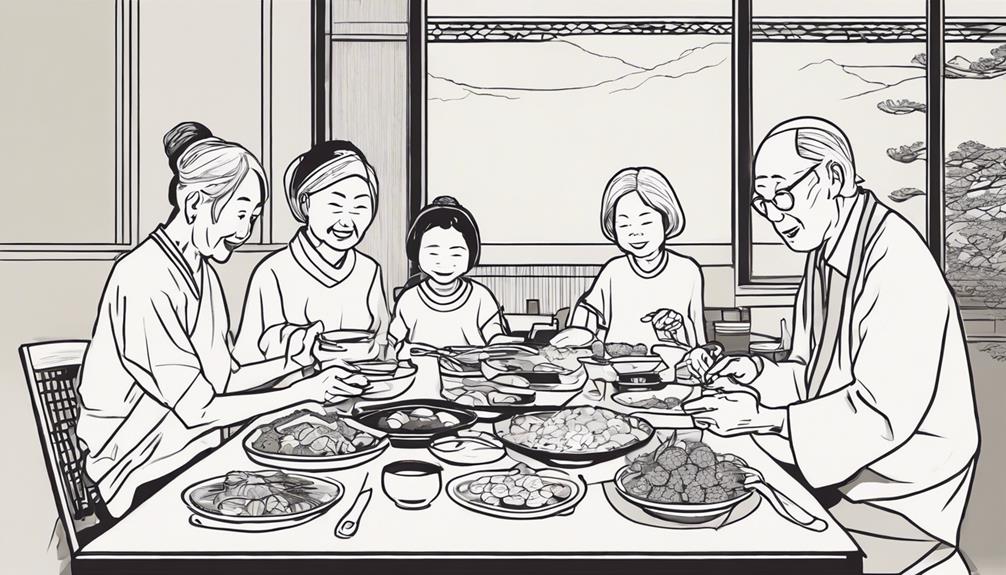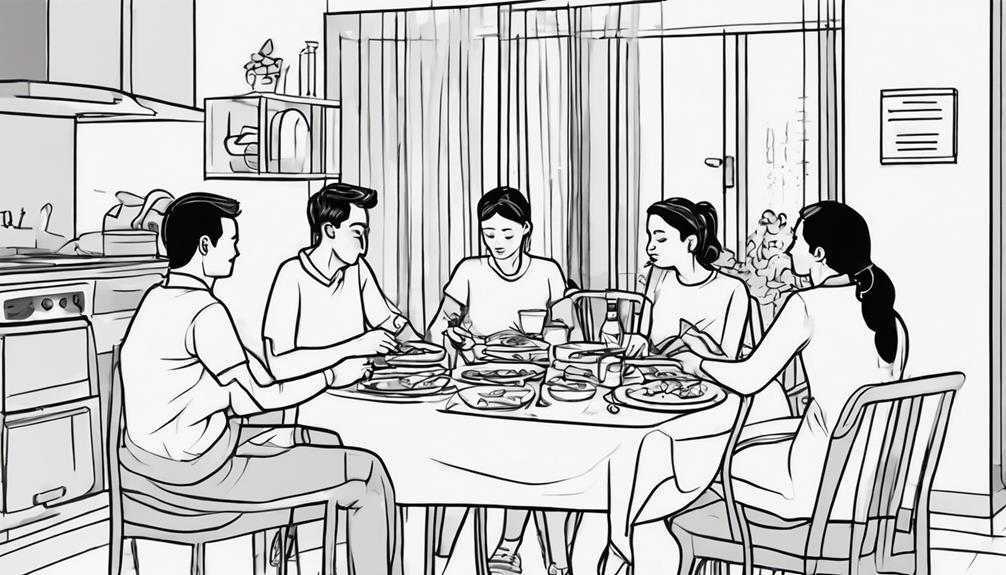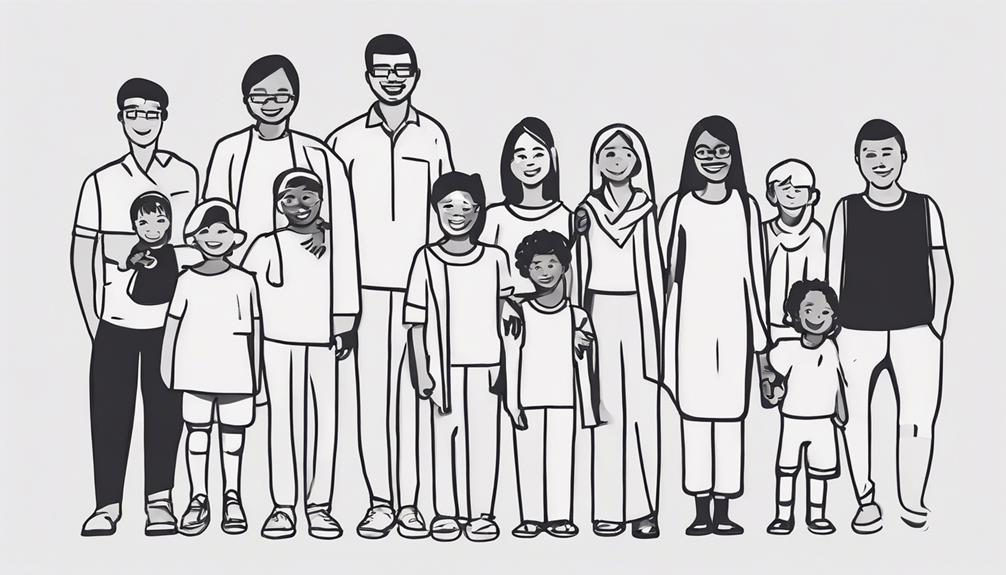Through an anthropological lens, the exploration of familial structures across borders unveils a tapestry of diversity and complexity. From the collectivist values engrained in Eastern societies to the individualistic ethos prevalent in the West, the fabric of family life is intricately woven with cultural threads. Understanding how values, traditions, and external influences shape familial dynamics is not merely an academic exercise but a profound journey into the heart of human interconnectedness. As we peel back the layers of cultural nuance, a deeper appreciation for the intricate tapestries of global families emerges, inviting us to ponder the profound impact of societal norms on the most intimate unit of society.
Key Takeaways
- Family structures vary globally, from nuclear to communal living models.
- Cultural norms influence family dynamics and caregiving responsibilities.
- Government policies shape family relationships and societal norms.
- Socioeconomic factors impact family well-being and access to resources.
Family Dynamics Worldwide

Family dynamics worldwide vary significantly based on cultural, religious, and societal norms, shaping the fundamental structure and functions of familial units across different regions. In many Western societies, the nuclear family, consisting of parents and their children, is considered the basic unit. This model emphasizes emotional bonds and mutual support within a small family unit. However, in contrast, regions like India and China perceive the family as a broader cultural and religious unit, extending beyond the nuclear family to include extended relatives.
The concept of nuclear families as the norm is often promoted by functionalists, who argue that this structure is essential for social stability and individual well-being. Nevertheless, in some societies, such as those that accept polygamous relationships, the idea of a nuclear family is not as prevalent. Moreover, alternative family structures like communes and kibbutzim challenge the traditional nuclear family model by promoting communal living, shared responsibilities, and equality among members. These diverse family dynamics across the globe highlight the complex interplay of cultural, religious, and societal influences on familial structures.
Cultural Variations in Family Structures
Amidst the diverse cultural landscapes around the world, the structures of familial units exhibit a myriad of variations and intricacies that reflect the unique values and traditions of each society. Traditional nuclear families serve as the foundation of many cultures, yet the dynamics within these structures can differ significantly. Here are some examples:
- In Vietnam, intergenerational living arrangements are common, emphasizing strong family bonds and close relationships with extended family members.
- Papua New Guinea places a high value on family support, with expectations, respect, and reciprocity playing essential roles within nuclear families.
- Indian families prioritize loyalty and interdependence, often making decisions in consultation with elders and maintaining financial security within large, multigenerational family setups.
- Kenyan culture emphasizes family as a top priority, nurturing strong connections between immediate and extended family members with a deep sense of pride and significance.
These examples highlight the diversity of family structures worldwide, showcasing the importance of traditional nuclear families while also demonstrating the unique cultural variations that shape familial dynamics.
Government Policies Impacting Families

Considering the intricate interplay between governmental regulations and societal structures, it is evident that policies established by authorities wield significant influence over the dynamics and compositions of familial units on a global scale. Government policies on families vary significantly worldwide, impacting family structures and dynamics. For instance, China's one-child policy, which was eventually abolished in 2016, led to low birth rates and an aging population. Failure to comply with birth permits in China could result in severe sanctions, such as forced abortions. On the other hand, over 2% of Israel's population resides in kibbutzim, which are cooperative living communities shaped by specific government policies. To further illustrate the impact of government policies on families globally, the table below highlights some key examples:
| Country | Policy | Impact |
|---|---|---|
| China | One-child policy | Low birth rates, aging population, forced abortions for non-compliance |
| Israel | Kibbutzim communities | Cooperative living, communal child-rearing, shared resources |
| Worldwide | Varied family policies | Diverse family structures, societal norms, and dynamics |
These examples demonstrate the far-reaching effects that government policies can have on shaping familial relationships and structures.
Alternative Family Models
Within societal frameworks, diverse family structures emerge to reflect evolving values and preferences. Communal living is an alternative family model that offers unique setups based on shared beliefs or environmental values. For example, kibbutzim in Israel promote cooperative living and equality among residents, highlighting the communal approach to family life. Similarly, communes were popular in the U.S. during the 1960s and 70s, showcasing a trend towards communal living arrangements. This model of living promotes democracy, shared responsibilities, and close bonds among members, fostering a sense of community and interconnectedness. Beyond the traditional nuclear family structure, some families worldwide opt for communal living arrangements, seeking a different way to organize and experience family life. By exploring alternative family models like communal living, societies can expand their understanding of family dynamics and cultivate diverse approaches to relationships and shared responsibilities.
Impact of Socioeconomic Factors on Families

Socioeconomic factors play a crucial role in shaping family dynamics and structures across different societies. Income levels can significantly influence the relationships and interactions within a family unit. Additionally, education and employment opportunities contribute to defining household structures and parental roles within families.
Income and Family Dynamics
The influence of income on family dynamics is a critical aspect that varies significantly across different countries. Income disparities play a crucial role in shaping the overall well-being and structure of families. Here are some key points to consider:
- Access to Resources: Disparities in income can impact a family's access to essential resources such as healthcare, education, and adequate living conditions.
- Challenges Faced: Families in lower income brackets often face challenges in meeting basic needs and maintaining stability within the household.
- Impact on Decision-Making: Economic opportunities, or the lack thereof, can significantly influence family structures and decision-making processes.
- Support Systems: Socioeconomic status can determine the level of support systems available to families, affecting their resilience and overall functioning.
Education and Household Structure
Income disparities have a profound impact on the educational opportunities available to families and the overall structure of households in different countries. Socioeconomic factors significantly shape family dynamics, with varying levels of access to education globally influencing household structures. Urbanization further plays a role in shaping community structures, affecting resources and support systems available to families. Access to education is crucial for the well-being of families, with disparities in educational opportunities impacting the overall welfare of households. These disparities not only affect the individual opportunities for family members but also influence the cohesion and functioning of the household as a whole. Therefore, understanding the interplay between income, education, and household structure is essential for comprehending the complexities of family life across different countries.
Employment and Parental Roles
In many Western countries, the trend towards dual-income households has reshaped traditional family dynamics, impacting how parents navigate their roles in the workforce and at home.
- Government policies in countries like Sweden and Norway support parental leave and work-life balance.
- Socioeconomic factors can influence the division of labor within families, with lower-income families facing challenges balancing work and parenting.
- Traditional gender roles persist in some Asian countries, with women predominantly shouldering childcare and household responsibilities.
- Access to affordable childcare and flexible work arrangements play a significant role in how families balance employment and parental roles globally.
Family Care Practices Globally

Across diverse cultures worldwide, family care practices exhibit unique approaches and values that shape the dynamics of caregiving within communities. Family structures vary significantly, with some cultures emphasizing extended family living arrangements to provide care and support for each other. In Asian countries, cultural practices such as filial piety underscore the importance of caring for elderly family members, while in Africa, traditional family care practices often revolve around communal support systems for childcare and eldercare. Nordic countries like Sweden prioritize family care through policies such as parental leave and support for working parents. In contrast, countries like Kenya rely on strong bonds and mutual assistance among relatives for emotional and financial support. These diverse approaches to family care reflect the values and priorities of each culture, highlighting the significance of familial relationships in providing essential care and support within communities globally.
Impact of Globalization on Family Units
Globalization has brought about significant changes in family structures worldwide, impacting cultural norms, economic dynamics, and gender roles within households. As societies become more interconnected, traditional family values are being reshaped by global influences, leading to a blend of tradition and modernity in familial relationships. Economic challenges arising from globalization, coupled with the influence of Western ideals, are prompting families to adapt to new ways of living and interacting with one another.
Cultural Shifts in Families
The evolution of family structures across diverse societies under the influence of global interconnectedness highlights significant cultural shifts in values and norms. These shifts are evident through various trends:
- Globalization Impact: Globalization has influenced family structures, leading to a blend of traditional and modern practices.
- Westernization Influence: Western ideals have shaped family dynamics in many nations, emphasizing individualism over collectivism.
- Migration and Urbanization: Increased movement and urban living have given rise to more nuclear families and dual-income households.
- Technological Advancements: Technology and social media have transformed communication within families, impacting relationships and interactions.
Economic Challenges Faced
Cultural transformations within family structures worldwide, particularly in response to economic challenges stemming from globalization, underscore the profound impact on the dynamics of family units. Globalization has brought about economic challenges that significantly impact families across the globe. The table below illustrates some key effects of globalization on family economics:
| Effects of Globalization on Family Economics |
|---|
| Increased competition for jobs |
| Financial strain due to rising cost of living |
| Reduced employment opportunities due to job outsourcing |
These challenges have created obstacles for families in maintaining income stability, job security, and meeting their basic needs. Developing countries, in particular, bear a heavier burden, affecting the overall well-being of families. The economic landscape shaped by globalization continues to shape the dynamics of family units worldwide.
Family Support Systems Across Nations

Across nations, the diversity and complexity of family support systems reflect a shared understanding of the importance of parental involvement in a child's upbringing. Family support systems vary worldwide, but some commonalities exist:
- Parental Involvement: Majority in 29 countries believe a child needs both parents for a happy upbringing.
- Emphasis on Marriage: Most adults globally see marriage as relevant and support the emphasis on family life.
- Importance of Both Parents: There is a strong belief globally that children need both parents for happiness, with support for the mother-father family being high in regions like South America, Europe, the Middle East, Africa, and Asia.
- Relevance of Marriage: Overwhelming global agreement exists that marriage is not outdated.
These factors highlight the significance placed on family structures and the role of parents in providing support and stability for children across different cultural contexts. The global consensus on the importance of family support systems underscores a fundamental aspect of societies worldwide.
Gender Roles in Family Dynamics
Gender roles within families play a crucial role in shaping societal norms and expectations. The division of household labor and parenting responsibilities often reflect these roles, impacting the dynamics within a family unit. Understanding these aspects is essential in comprehending the broader cultural and social structures that influence family life across different countries.
Role Expectations and Gender
Within various societies globally, distinct expectations regarding roles based on biological sex shape the dynamics and functioning of families. Gender roles in family dynamics can vary significantly across cultures, influencing decision-making processes, resource allocation, and power dynamics within the household. Some countries, like India and Kenya, adhere strongly to traditional gender roles, assigning specific responsibilities based on gender. In contrast, cultures in Scandinavian countries have made notable progress in promoting gender equality within family structures. These gender expectations impact individual freedoms, social status, and access to opportunities, underscoring the necessity of recognizing and understanding diverse cultural norms in family life. Gender roles play a crucial role in shaping family dynamics and relationships, reflecting broader societal values and norms.
Division of Household Labor
The varying expectations regarding roles based on biological sex within families globally manifest prominently in the division of household labor, reflecting deeply ingrained cultural norms and values. In many countries, gender roles dictate that women bear the primary responsibility for household chores and childcare, perpetuating traditional beliefs. Contrarily, Nordic countries like Iceland and Sweden exhibit a more equal distribution of household labor between men and women, showcasing a progressive approach to gender roles. However, in countries like Japan, despite an increasing number of women entering the workforce, they still predominantly shoulder the burden of domestic tasks. Similarly, in nations such as India and Pakistan, strong gender role divisions persist, with women predominantly handling domestic responsibilities. Research suggests that a more equitable division of household labor is associated with higher marital satisfaction and relationship stability, highlighting the importance of addressing gender roles within family dynamics.
Parenting Responsibilities
In various cultural contexts worldwide, distinct patterns emerge in the allocation of parenting responsibilities within family structures.
- In many traditional cultures, parenting responsibilities are often divided along gender lines, with women primarily responsible for childcare and household duties.
- Countries like Sweden and Norway emphasize shared parenting responsibilities, with both men and women actively involved in raising children.
- Gender roles in parenting are evolving in the United States, with more fathers taking on active roles in childcare and household management.
- Some cultures, such as in parts of Africa and the Middle East, strictly dictate that women are solely responsible for caregiving and homemaking duties.
Gender roles play a significant role in shaping the dynamics of parenting responsibilities, influenced by societal norms, cultural beliefs, and economic factors across different countries.
Technological Influence on Family Life
Technology's pervasive influence on family dynamics is undeniable, significantly altering the way families communicate and interact in the modern era. The advent of digital devices and social media platforms has revolutionized family life globally. While technology enables long-distance communication, it also poses challenges to face-to-face interactions within families. Increased screen time can lead to a decrease in the quality of family time, as individuals get absorbed in their virtual worlds. Moreover, the constant connectivity offered by technology can blur boundaries between work and home life, affecting family relationships. Virtual connections through social media platforms can both strengthen and strain family bonds, depending on how they are utilized. It is essential for families to strike a balance between the benefits and drawbacks of technology to maintain healthy relationships and meaningful interactions. Being mindful of the impact of digital devices on family dynamics is crucial in navigating the evolving landscape of family life in the digital age.
Educational Systems and Family Values

Given the evolving landscape of family dynamics influenced by technological advancements, the correlation between educational systems and family values in different countries becomes a focal point of examination. When exploring how educational systems impact family values, several key differences emerge globally:
- Finland: Prioritizes holistic development and individualized learning approaches, fostering a well-rounded educational experience that aligns with family ideals.
- Japan: Values academic achievement highly, leading to rigorous education and exam-based systems that may shape family expectations and dynamics.
- South Korea: Emphasizes parental involvement in education and sets high expectations for academic success, reflecting strong family values around achievement.
- Germany: Focuses on vocational training alongside academic education, reflecting the value placed on practical skills within families.
These diverse approaches to education not only shape the knowledge and skills children acquire but also influence the values and expectations families hold regarding learning and success. Understanding these global variations can provide insights into how family dynamics and educational systems intersect to shape societal norms and individual experiences.
Health and Well-being in Global Families
Health and well-being outcomes within global families exhibit a range of disparities influenced by factors such as access to healthcare, socioeconomic conditions, and cultural norms. Countries like Norway and Switzerland, known for their strong healthcare systems and high socioeconomic status, often rank high in health and well-being indicators for families. On the other hand, in developing countries, the lack of healthcare infrastructure and resources can significantly impact family health outcomes. Disparities also exist in mental health support for families globally, with some countries offering more comprehensive services than others. Cultural attitudes towards health practices and wellness further shape family well-being worldwide. Understanding these factors is crucial in addressing the diverse health needs of families across the globe. By recognizing the importance of healthcare access, socioeconomic conditions, and cultural influences, policymakers and healthcare providers can work towards improving the health and well-being outcomes of families on a global scale.
Resilience and Adaptability in Family Structures

Global families showcase diverse levels of resilience and adaptability in facing adversities and embracing changes, with cultural influences playing a significant role in shaping their responses. Resilient family structures often rely on strong support networks, communication, and flexibility. Adaptive families in different countries may prioritize different aspects such as tradition, modernity, or community ties. Understanding the resilience and adaptability of families worldwide can offer valuable insights into coping mechanisms and strengths across diverse cultures. Cultural norms and values greatly influence how families navigate adversity and maintain cohesion. By studying how families from various parts of the world handle challenges, we can learn about the importance of resilience in maintaining family bonds and overcoming obstacles. The ability of families to adapt to changing circumstances highlights the dynamic nature of family structures and the importance of cultural context in shaping their responses to adversity.
Frequently Asked Questions
How Is Family Different in Different Countries?
Family dynamics vary significantly across cultures, shaped by unique cultural traditions. These differences manifest in familial structures, roles, and values. Understanding these variations provides insight into the importance of family in societal contexts. By exploring how cultural norms influence family dynamics, we gain a deeper appreciation for the diverse ways in which families function globally. Cultural traditions play a pivotal role in shaping familial relationships and behaviors across different countries.
How Do Families Differ From One Another?
Parenting styles vary significantly among families due to cultural, societal, and individual differences. These variations can include authoritarian, authoritative, permissive, or uninvolved parenting approaches, influencing child development outcomes. Factors such as communication patterns, disciplinary strategies, and expectations for children's behavior can differ, shaping the overall family dynamic. Understanding these differences is crucial for promoting effective parenting practices and fostering healthy family relationships across diverse cultural contexts.
What Are the 5 Ways Families Differ Worldwide?
Families worldwide exhibit diversity in cultural norms influencing their structures, dynamics, and values. Variations in kinship systems, societal expectations, and traditions shape family units. Decision-making processes, roles within the family, and interconnectedness differ significantly across cultures. Attitudes towards marriage, child-rearing practices, and gender roles also play a crucial role in distinguishing family dynamics globally. Understanding these nuances provides insight into the multifaceted nature of families around the world.
What Are the Different Family Forms Around the World?
Various family forms exist globally, influencing parenting styles. These can range from nuclear families prevalent in Western cultures to joint families in Asian societies. Additionally, polygamous arrangements are accepted in certain regions. Childrearing practices vary, with some cultures emphasizing communal support in extended family settings. Understanding these diverse family structures provides insight into the intricacies of parenting dynamics across different societies.
Conclusion
In conclusion, the diverse family structures and dynamics worldwide highlight the impact of cultural norms, government policies, socioeconomic factors, and technology on family life. As families continue to evolve and adapt to changing societal conditions, one must ponder: How do families navigate the complexities of global influences while preserving their core values and traditions?
